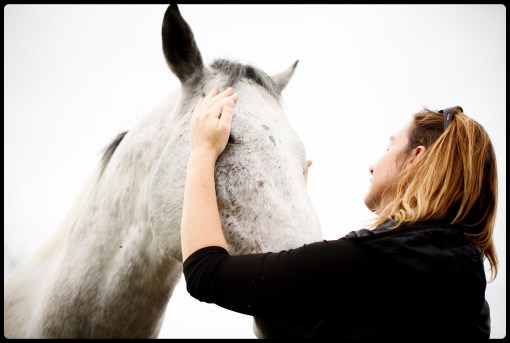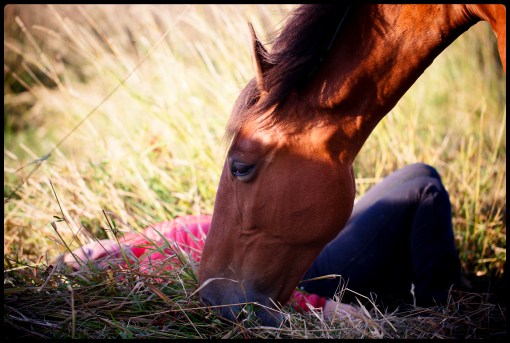The Project:
Mustangs directly off the range, One Trainer, Many Students, Communication through body language, Tools used only for safety, never to train.
The Goal:
To discover how far Equestrian Art can be developed solely using body language.
Positive Stress
Sitting on a train on my way to the Brussels airport where I will fly to Portugal for the next workshop, I have a few moments to write down some thoughts.
This teaching trip has been an amazing opportunity to see the work I do in Freedom Based Training through different eyes yet again. Though I am teaching the same ideas I learned with Myrnah while filming the movie Taming Wild, every place I go and every group I share with asks questions that help me see things from a different angle. The more teaching I do, the better I get at explaining the ideas. I always joke that by the time I am ninety-years old I will be very, very good at this!
For now I will share what I know. I will share the things that have worked for me, and all the while I will watch my students carefully and take note of the things that work for them.
The students in New Jersey are different from the students in Ireland, and different from the students in the UK, and different from Belgium and Portugal. Yet, even with all the variation, there are more commonalities than differences, and those commonalities let me know I am on the right path teaching what I am teaching in Freedom Based Training. We all simply see things from slightly different angles.
If you had told me six years ago this life of international travel and worldwide friends would be my way of life, I would have laughed. Six years ago I was a small-town single parent with a small-town horse habit that I supported with a small-town business of teaching and training horses and people to the best of my ability. I had no plans or thoughts of ever building a life that was bigger in any significant way.
Even when a student asked me those pivotal questions that became the birth of Taming Wild and everything that was to become Freedom Based Training… even then I had no thoughts beyond my small quiet and personal experience. I started writing a blog that I thought a few people might read, and then I made a movie that I thought a few people might enjoy.
Even when the movie picked up momentum and I started to teach a few people the things I had done in the movie… even then I had no real understanding that this all was becoming so much bigger than anything I had ever imagined or anticipated.
Here I am six years later finally embracing the reality that all this is so much bigger than just me and my simple quiet life tucked in the northwest corner of the United States. And so, as life gets bigger and more complicated for me, I am finding myself considering the role that stress plays for all of us. For horses and humans alike, life sometimes gets bigger and more full of events than we had ever anticipated.
Sitting in a pub, late in the evening with Nicole in the UK, we were talking about stress and the positives and negatives, and how that is unique to different individuals. Why is that? What is it that makes stress a good or a bad thing?
I believe stress is a continuum and some stress is the vitality of life. Stress is the thing that causes us to be interested, to seek answers, to play. Life without any stress would become stagnant and uninteresting. Some people would simply call the positive side of the spectrum “interesting” instead of stress; however, something interesting to one person (or horse) is terrifying to another person (or horse). So I think, if we can call the complete spectrum by the same name, we gain understanding of how others feel when it is different from how we feel.
I believe we can see the level of stress a person or a horse is feeling by how they exhibit Fight, Flight or Freeze: Depending on where for them this stress is on the spectrum, they will be more or less functional in relationship with others.
All of us have a moving target of how much stress might be a positive factor in our lives, and how much stress might begin to feel like too much – threatening injury and destruction instead of the growth and development we all hope for.
I believe this is a very simple equation.
- Too much stress will drive us apart from others and cause us to feel alone.
- The right amount of stress will foster and support bonding and relationships.
- Not enough stress will eventually become stressful in it’s own way as growth is what helps us connect to others.
Like almost everything I teach and believe in, the essential concepts are simple, but the depth of understanding is profound.
The right amount of stress for any individual is going to depend on more factors than we will ever be able to control, so, as any good horse trainer does, I look for the controllable factors.
- Any experience outside of the comfort zone is going to increase stress.
- Leadership and movement decrease stress.
- Harmony, Flow, Matching, and Mirroring make the most of the bonding opportunities, building relationships with our horses when stress is at a functional level.
So that brings us to the question, how do we read our horses stress levels and see what is developing so we can take appropriate action with appropriate feel and timing?
These coping mechanisms are familiar to almost everyone: Fight, Flight and Freeze.
What I think are not talked about enough are the positive and beneficial sides of Fight, Flight and Freeze.
Flight can be displayed functionally when a horse simply and easily moves away from pressure or discomfort. It can also be displayed in a dysfunctional way in the form of bolting at high speed with no thought of what obstacles lie in the path of travel.
Fight can be displayed functionally when a horse is playful. It can also be displayed in a dysfunctional way as an attack of hooves and teeth.
Freeze can be displayed functionally when a horse pauses for a long moment to think before taking action. It can also be displayed in a dysfunctional way when a horse becomes catatonic or rigid or unresponsive to all outside stimuli.
Stress-coping mechanisms exist on a range and what is functional for one horse or human is not for another. These ideas will need to be adapted to the uniqueness of any partnership.
When we see the physical manifestations of stress, we need to ask ourselves, on a spectrum is this stress getting better or is this stress getting worse? For this unique relationship that I am in, does this amount of stress foster and support our relationship?
As we assess this from moment to moment it gives us a gauge of what we might do to help develop a better relationship with our horses.
Quite simply, if the stress is positive and enhancing the relationship, we need to offer the horse more harmony, flow, matching, and mirroring behaviors.
If the stress is becoming less functional for the relationship at hand, we need to offer more leadership and more movement.
This need for leadership causes us to ask what is leadership?
I believe leadership is the ability to make decisions that result in more harmony in a relationship.
Most horse training is done in a dominant way to some degree, where there is a building of pressure of some sort until a horse finds harmony with the human. When this is done well it is the fastest way to lower stress and find common ground in the relationship.
Freedom Based Training is about coming at the relationship from the other side: Passive leadership. This concept of Passive leadership is where we make decisions for our own body until we find ways to develop harmony with the horse, without needing anything from the horse. This is the slowest way to develop leadership and lower stress, however, the benefit in going slow is we have a better chance of having good feel and timing and being successful, even if it takes longer.
The higher the stress level a horse has, the better feel and timing a trainer must have to be successful at lowering stress to a place where bonding and connection are possible. If you choose dominant leadership, your skill might need to be very good indeed to be successful. If you choose Passive Leadership, it is the slower path, and all you need is mindful persistence of when to make decisions and when to flow with your horse.
In Freedom Based Training we learn how to read our horse, matching and mirroring them any time they are making efforts to lower their stress and connect with us more deeply, and offering them more good decisions any time they need help moving their stress in a better direction.
I believe relationships are all about feel and timing: when to be a leader and when to be a partner; and, regardless of which we choose, the overarching goal is always to have a positive level of stress and a better relationship as a result.
The better our relationship gets and the more functional the stress habits become, the more we can operate in a give and take easy back and forth of partnership and decisions. Those are the moments I live for with horses.
And then, at the end of the day, when I am sitting on a plane or a train and sorting out all the differing stresses in my own life, I have to consider perhaps this is not just about horse training… Overall in my life is this a functional stress level for me? Or am I starting to feel more alone and isolated in my stress? No matter what the answer is, I just spelled out the solutions.
Too stressed and isolated? Start making more and better decisions…
When I feel just the right amount of Fight (playfulness) Flight (adaptability to pressure) and Freeze (thoughtfulness), then my job is to roll with it, Harmonize and Flow with my life….
But honestly, training horses is so much easier than managing my own life. 😉
Hopefully this is good food for thought as you build your own relationships.
After Portugal I know I can’t wait to be back home, feet in the dirt, feeling fur in my fingers and the breath of horses on my neck again.
Hooves and Heartbeats,
Elsa






































































